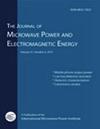Effect of input microwave power and insulation on microstructure and tensile properties of cast Al 7039 alloy produced at 2.45 GHz
IF 1.5
4区 工程技术
Q4 ENGINEERING, CHEMICAL
Journal of Microwave Power and Electromagnetic Energy
Pub Date : 2020-10-01
DOI:10.1080/08327823.2020.1838049
引用次数: 3
Abstract
Abstract In the present work, microwave energy was used for casting Al 7039 alloy at 2.45 GHz in the ambient cavity environment. Effects of input power and insulation of the mould assembly during irradiation on charge melting and mould preheating were studied. Five different casts were produced at 1000 W, 1200 W, 1400 W, 1400 W with an insulated pouring basin and 1400 W with insulated mould assembly. Melting time of the charge was the least while using 1400 W with insulated mould assembly, whereas preheating of the mould was observed minimum during casting at 1400 W inside an insulated pouring basin. Cast microstructures revealed that less preheating of the mould resulted in finer grains and intermetallics, which improve tensile properties of the cast. Fractographic analyses showed the presence of coarse intermetallics in the casts produced with insulated mould assembly, which resulted in significant reduction of tensile properties.输入微波功率和绝缘对2.45 GHz铸造Al 7039合金组织和拉伸性能的影响
摘要:在常温空腔环境下,利用2.45 GHz微波能量铸造Al 7039合金。研究了辐照过程中输入功率和模具组件绝缘对装料熔化和模具预热的影响。生产了五种不同的铸件,分别为1000w、1200w、1400w、1400w带绝缘浇注盆和1400w带绝缘模具组件。当使用1400 W的绝缘模具组件时,装料的熔化时间最短,而在1400 W的绝缘浇注盆内浇注时,观察到模具的预热时间最短。铸型显微组织表明,减少模具预热使铸件的晶粒和金属间化合物更细小,从而提高了铸件的拉伸性能。断口分析表明,在使用绝缘模具组件生产的铸件中存在粗糙的金属间化合物,这导致拉伸性能显著降低。
本文章由计算机程序翻译,如有差异,请以英文原文为准。
求助全文
约1分钟内获得全文
求助全文
来源期刊

Journal of Microwave Power and Electromagnetic Energy
ENGINEERING, CHEMICAL-ENGINEERING, ELECTRICAL & ELECTRONIC
CiteScore
2.50
自引率
6.70%
发文量
21
期刊介绍:
The Journal of the Microwave Power Energy (JMPEE) is a quarterly publication of the International Microwave Power Institute (IMPI), aimed to be one of the primary sources of the most reliable information in the arts and sciences of microwave and RF technology. JMPEE provides space to engineers and researchers for presenting papers about non-communication applications of microwave and RF, mostly industrial, scientific, medical and instrumentation. Topics include, but are not limited to: applications in materials science and nanotechnology, characterization of biological tissues, food industry applications, green chemistry, health and therapeutic applications, microwave chemistry, microwave processing of materials, soil remediation, and waste processing.
 求助内容:
求助内容: 应助结果提醒方式:
应助结果提醒方式:


